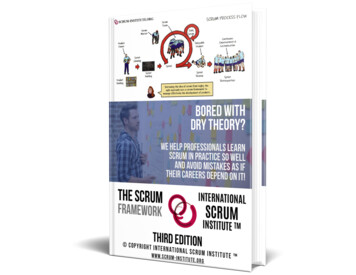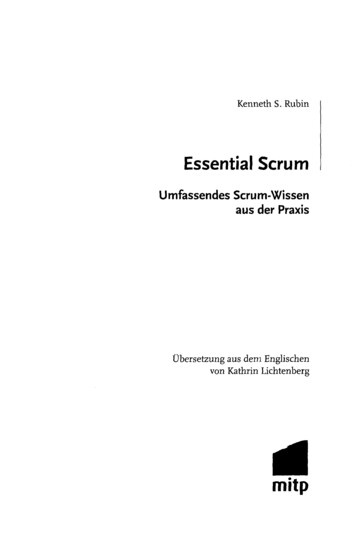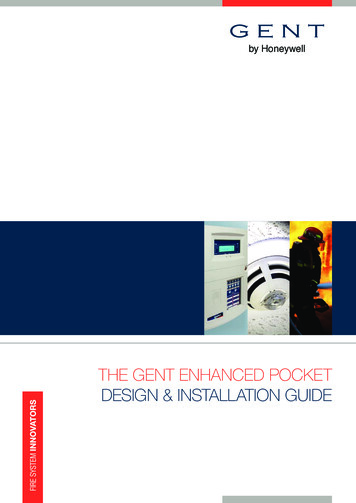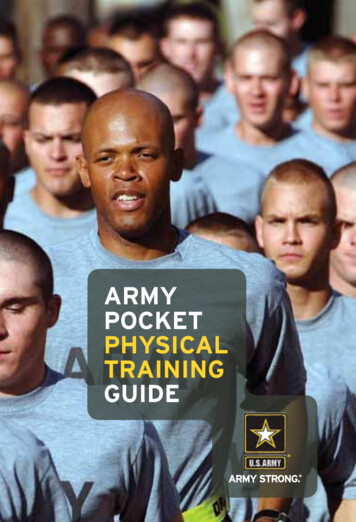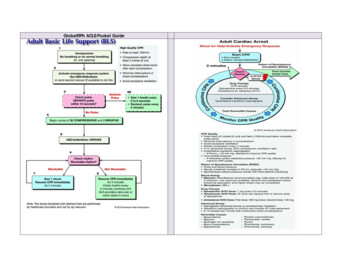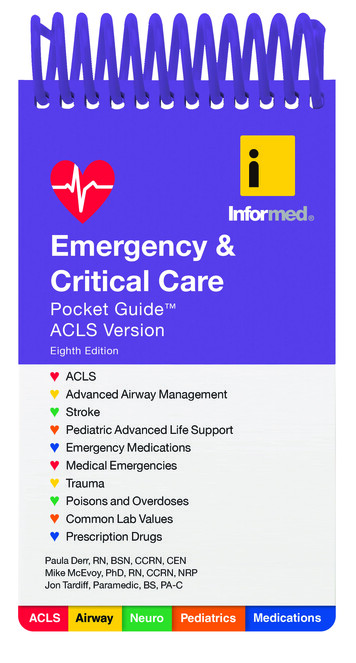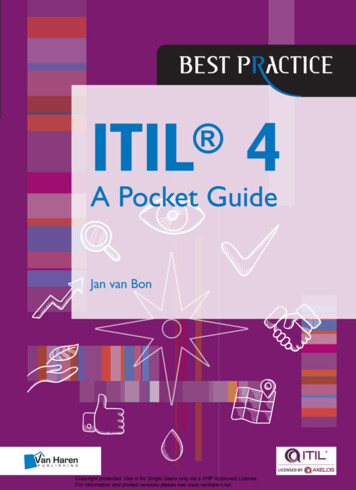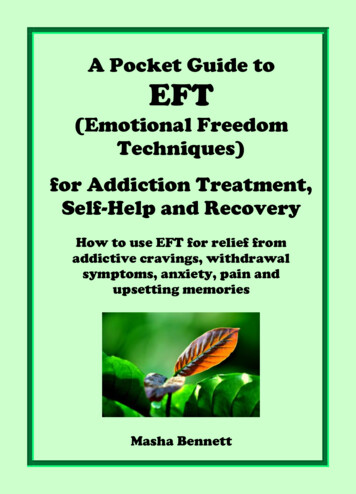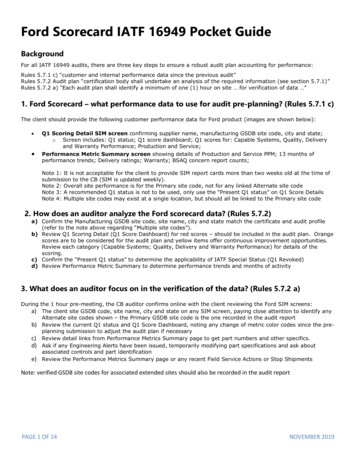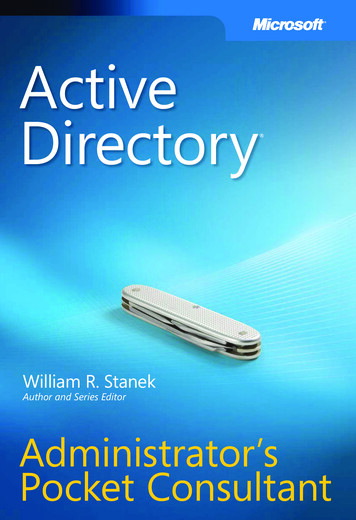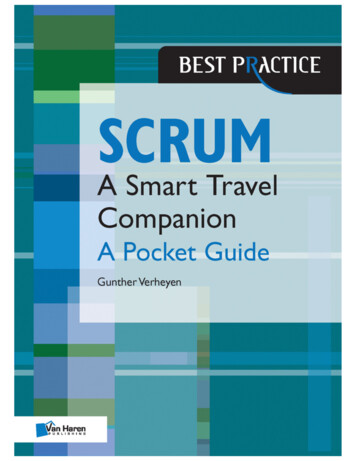
Transcription
Scrum – A Pocket Guide
Other publications by Van Haren PublishingVan Haren Publishing (VHP) specializes in titles on Best Practices, methods and standardswithin four domains:- IT and IT Management- Architecture (Enterprise and IT)- Business Management and- Project ManagementVan Haren Publishing offers a wide collection of whitepapers, templates, free e-books, trainermaterials etc. in the Van Haren Publishing Knowledge Base: www.vanharen.net for moredetails.Van Haren Publishing is also publishing on behalf of leading organizations and companies:ASLBiSL Foundation, BRMI, CA, Centre Henri Tudor, Gaming Works, IACCM, IAOP,Innovation Value Institute, IPMA-NL, ITSqc, NAF, Ngi/NGN, PMI-NL, PON, The OpenGroup, The SOX Institute.Topics are (per domain):IT and IT ManagementABC of ICTASL CATS CM CMMI COBIT e-CFISO 20000ISO 27001/27002ISPLIT-CMFTMIT Service CMMITIL MOFMSFSABSAArchitecture(Enterprise and IT)Project, Program and RiskManagementArchiMate GEA Novius Architectuur MethodeTOGAF A4-ProjectmanagementDSDM/AternICB / NCBISO 21500MINCE M o R MSP P3O PMBOK GuidePRINCE2 Business ManagementBABOK GuideBiSL BRMBOKTMBTFEFQMeSCMIACCMISA-95ISO 9000/9001OPBOKSAPSixSigmaSOXSqEME
ScrumA Pocket GuideGunther Verheyen
um – A Pocket GuideA smart travel companionBest PracticeGunther VerheyenKen Schwaber (Scrum co-creator, Scrum.org)David Starr (Agile Craftsman, Microsoft)Ralph Jocham (Agile Professional,effective agile)Patricia Kong (Director of Partners,Scrum.org)Text editor:Publisher:Steve NewtonVan Haren Publishing, Zaltbommel,www.vanharen.net978 90 8753 720 3ISBN hard copy:ISBN eBook:Edition:First edition, first impression, October 2013First edition, second impression, January 2014First edition, third impression, June 2014First edition, fourth impression, November 2015First edition, fifth i mpression, November 2016Layout and typesetting:CO2 Premedia, Amersfoort – NLCopyright: Van Haren Publishing, 2013For any further enquiries about Van Haren Publishing, please send ane-mail to: info@vanharen.netAlthough this publication has been composed with most care, neitherAuthor nor Editor nor Publisher can accept any liability for damage causedby possible errors and/or incompleteness in this publication.No part of this publication may be reproduced in any form by print, photoprint, microfi lm or any other means without written permission by thePublisher.
Foreword by Ken SchwaberAn outstanding accomplishment that simmers with intelligence.Scrum – A Pocket Guide is an extraordinarily competent book.Gunther has described everything about Scrum in well-formed,clearly written descriptions that flow with insight, understanding, andperception. Yet, you are never struck by these attributes. You simplybenefit from them, later thinking, “That was really, really helpful.I found what I needed to know, readily understood what I wanted, andwasn’t bothered by irrelevancies.”I have struggled to write this foreword. I feel the foreword shouldbe as well-written as the book it describes. In this case, that is hard.Read Gunther’s book. Read it in part, or read it in whole. You will besatisfied.Scrum is simple, but complete and competent in addressing complexproblems. Gunther’s pocket guide is complete and competent inaddressing understanding a simple framework for addressing complexproblems, Scrum.Ken, August 2013
PrefaceThe use of Agile methods continues to grow traction and Scrum isthe most widely adopted method for Agile soft ware development. Thegeneral level of interest in Scrum is therefore considerable.Transforming an organization’s development approach to Scrumrepresents quite a challenge. Scrum is not a cookbook ‘process’ withdetailed and exhaustive prescriptions for every imaginable situation.Scrum is a framework of principles, roles and rules that thrive on thepeople doing Scrum. The true potential of Scrum lies in the discoveryand emergence of practices, tools and techniques and in optimizingthem for each organization’s specific context. Scrum is very muchabout behavior, much more than it is about process.The benefits an organization realizes with Scrum depend on the willto remove barriers, think across boxes and embark on a journey ofdiscovery.The journey starts by playing Scrum. Th is requires knowledge of therules of Scrum. Th is book describes these. Th is book shows how Scrumimplements the Agile mindset, what the rules of the game of Scrumare, and how these rules leave room for a variety of tactics to play
8Scrum – A Pocket Guidethe game. The introduction of all essentials of Scrum and the mostcommon tactics for Scrum makes this book a worthwhile read forpeople, teams, managers and change agents, whether they are alreadydoing Scrum or want to embark on the journey of Scrum.Ten years ago I started my journey, my path of Agility via Scrum. Ithas inevitably been a cobblestone path. On my journey I have usedScrum with plenty of teams, in various projects, and at differentorganizations. I have worked with both large and small enterprisesand have coached teams as well as executive management. I wasin the fortunate position of then moving to Scrum.org. It’s where Ishepherd the ‘Professional’ series of Scrum trainings, courseware andassessments.I thank Ken Schwaber, David Starr, Ralph Jocham, and Patricia Kongfor reviewing early versions of this book and improving it with muchappreciated feedback.I thank all at Van Haren Publishing for their trust and confidence, andfor giving me the chance to express my views on Scrum with this book.I thank my colleagues at Scrum.org for our daily collaboration, thepositive action and the energy, and especially Ken Schwaber for ourexquisite partnership.Enjoy reading, and. keep Scrumming.Gunther, June 2013
ReviewsTh is Scrum Pocket Guide is outstanding. It is well organized, wellwritten, and the content is excellent. Th is should be the de factostandard handout for all looking for a complete, yet clear overviewof Scrum.(Ken Schwaber, Scrum co-creator, Scrum.org)Gunther has expertly packaged the right no-nonsense guidance forteams seeking agility, without a drop of hyperbole. Th is is the bookabout agility with Scrum I wish I had written.(David Starr, Agile Craftsman, Microsoft)During my many Scrum training activities I often get asked: “ForScrum, what is the one book to read?” In the past the answer wasn’tstraight forward, but now it is! The Scrum Pocket Guide is the onebook to read when starting with Scrum. It is a concise, yet completeand passionate reference about Scrum.(Ralph Jocham, Agile Professional, effective agile.)‘The house of Scrum is a warm house. It’s a house where people areWELCOME.’ Gunther’s passion for Scrum and its players is evidentin his work and in each chapter of this book. He explains the Agileparadigm, lays out the Scrum framework and then discusses the‘future state of Scrum.’ Intimately, in about 100 pages.(Patricia M. Kong, Director of Partners, Scrum.org)
Contents123THE AGILE PARADIGM . . . . . . . . . . . . . . . . . . . . . . . . . . . . . . . . . . . . . 131.1To shift or not to shift . . . . . . . . . . . . . . . . . . . . . . . . . . . . . . . . . 131.21.31.41.5The origins of Agile . . . . . . . . . . . . . . . . . . . . . . . . . . . . . . . . . . 18Defi nition of Agile . . . . . . . . . . . . . . . . . . . . . . . . . . . . . . . . . . . 19The iterative-incremental continuum . . . . . . . . . . . . . . . . . . . 22Agility can’t be planned . . . . . . . . . . . . . . . . . . . . . . . . . . . . . . .261.6Combining Agile and Lean . . . . . . . . . . . . . . . . . . . . . . . . . . . .28SCRUM . . . . . . . . . . . . . . . . . . . . . . . . . . . . . . . . . . . . . . . . . . . . . . . . . . . 372.12.22.32.4The house of Scrum . . . . . . . . . . . . . . . . . . . . . . . . . . . . . . . . . . 37Scrum, what’s in a name? . . . . . . . . . . . . . . . . . . . . . . . . . . . . . 38Is that a gorilla I see over there? . . . . . . . . . . . . . . . . . . . . . . . . 41Framework, not methodology . . . . . . . . . . . . . . . . . . . . . . . . .442.52.62.7Playing the game . . . . . . . . . . . . . . . . . . . . . . . . . . . . . . . . . . . . .46Core principles of Scrum . . . . . . . . . . . . . . . . . . . . . . . . . . . . . . 61The Scrum values . . . . . . . . . . . . . . . . . . . . . . . . . . . . . . . . . . . . 71TACTICS FOR A PURPOSE . . . . . . . . . . . . . . . . . . . . . . . . . . . . . . . . . . 773.13.23.3Visualizing progress . . . . . . . . . . . . . . . . . . . . . . . . . . . . . . . . . . 78The Daily Scrum questions . . . . . . . . . . . . . . . . . . . . . . . . . . . . 79Product Backlog refi nement . . . . . . . . . . . . . . . . . . . . . . . . . . .80
12Scrum – A Pocket Guide3.43.53.63.74User Stories . . . . . . . . . . . . . . . . . . . . . . . . . . . . . . . . . . . . . . . . . 81Planning Poker . . . . . . . . . . . . . . . . . . . . . . . . . . . . . . . . . . . . . . 83Sprint length . . . . . . . . . . . . . . . . . . . . . . . . . . . . . . . . . . . . . . . . 83Scaling Scrum . . . . . . . . . . . . . . . . . . . . . . . . . . . . . . . . . . . . . . . 85THE FUTURE STATE OF SCRUM . . . . . . . . . . . . . . . . . . . . . . . . . . . . . 914.14.24.3Yes, we do Scrum. And . . . . . . . . . . . . . . . . . . . . . . . . . . . . . 91The power of the possible product . . . . . . . . . . . . . . . . . . . . . . 93The upstream adoption of Scrum . . . . . . . . . . . . . . . . . . . . . . 95Annex A: Scrum vocabulary . . . . . . . . . . . . . . . . . . . . . . . . . . . . . . . 101Annex B: References . . . . . . . . . . . . . . . . . . . . . . . . . . . . . . . . . . . . . . 105About the author . . . . . . . . . . . . . . . . . . . . . . . . . . . . . . . . . . . . . . . . .109
11.1The Agile paradigmTO SHIFT OR NOT TO SHIFTThe soft ware industry was for a long time dominated by a paradigm ofindustrial views and beliefs (figure 1.1). Th is was in fact a copy-pasteof old manufacturing routines and theories. An essential element inthis landscape of knowledge, views and practices was the Taylorist1conviction that ‘workers’ can’t be trusted to undertake intelligent andcreative work. They are expected to only carry out executable tasks.Therefore their work must be prepared, designed and planned bymore senior staff. Furthermore, hierarchical supervisors must stillvigilantly oversee the execution of these carefully prepared tasks.MethodologyPlanResource management utilizationProject ManagerDirectTasksControlMoney rewardsFigure 1.1 The industrial paradigm
14Scrum – A Pocket GuideQuality is assured by admitting the good and rejecting the bad batchesof outputs. Monetary rewards are used to stimulate desired behavior.Unwanted behavior is punished. It’s like carrots and sticks.The serious flaws of this paradigm in soft ware development are knownand well documented. In particular, the Chaos reports of the StandishGroup have over and over again revealed the low success rates oftradit ional soft ware development. The latest of these reports is dated2011 (Standish, 2011). Many shortcomings and errors resulting fromthe application of the industrial paradigm in soft ware development arewell beyond reasonable levels of tolerance. The unfortunate responseseems to have been to lower the expectations. It was accepted thatonly 10-20% of soft ware projects would be successful. Success in theindustrial paradigm is made up of the combination of on time, withinbudget and including all scope. Although these criteria for successcan be disputed, it is the paradigm’s promise. It became accepted thatquality is low, and that over 50% of features of traditionally deliveredsoft ware applications are never used (Standish, 2002).Although it is not widely and consciously admitted, the industrialparadigm did put the soft ware industry in a serious crisis. Many triedto overcome this crisis by fortifying the industrial approach. Moreplans were created, more phases scheduled, more designs made, morework was done upfront, hoping for the actual work to be undertakento be executed more effectively. The exhaustiveness of the upfrontwork was increased. The core idea remained that the ‘workers’ neededto be directed with even more detailed instructions. Supervision wasincreased and intensified.And still, little improved. Many flaws, defects and low quality had tobe tolerated.
1 The Agile paradigmIt took some time, but inevitably new ideas and insights startedforming following the observation of the significant anomalies of theindustrial paradigm. The seeds of a new world view were already sownin the 1990’s. But it was in 2001 that these resulted in the formalnaming of ‘Agile’, a turning-point in the history of soft waredevelopment. A new paradigm for the soft ware industry was born(figure 1.2); a paradigm that thrives upon heuristics and creativity, andrestoring the respect for the creative nature of the work and theintelligence of the ‘workers’ in soft ware development.DiscoveryFlowValueIntrinsic motivationPlanningPeople practicesLeadershipMasterySkillsFigure 1.2 The Agile paradigmThe soft ware industry has good reasons to move fast to the newparadigm; the existing flaws are significant, widely known and thepresence of soft ware in society grows exponentially, making it acritical aspect of our modern world. However, by defi nition, a shift toa new paradigm takes time. And the old paradigm seems to have deeproots. An industrial approach to soft ware development even continuesto be taught and promoted as the most appropriate one.15
16Scrum – A Pocket GuideMany say that Agile is too radical and they, therefore, propagate agradual introduction of Agile practices into the existing, traditionalprocess. However, there is reason to be very skeptical about a gradualevolution, a slow progression from the old to the new paradigm, fromwaterfall to Agile.The chances are quite high that a gradual evolution will never gobeyond the surface
05.10.2020 · Scrum – A Pocket Guide is an extraordinarily competent book. Gunther has described everything about Scrum in well-formed, clearly written descriptions that fl ow with insight, understanding, and perception. Yet, you are never struck by these attributes. You simply benefi t from them, later thinking, “# at was really, really helpful. I found what I needed to know, readily understood what .
